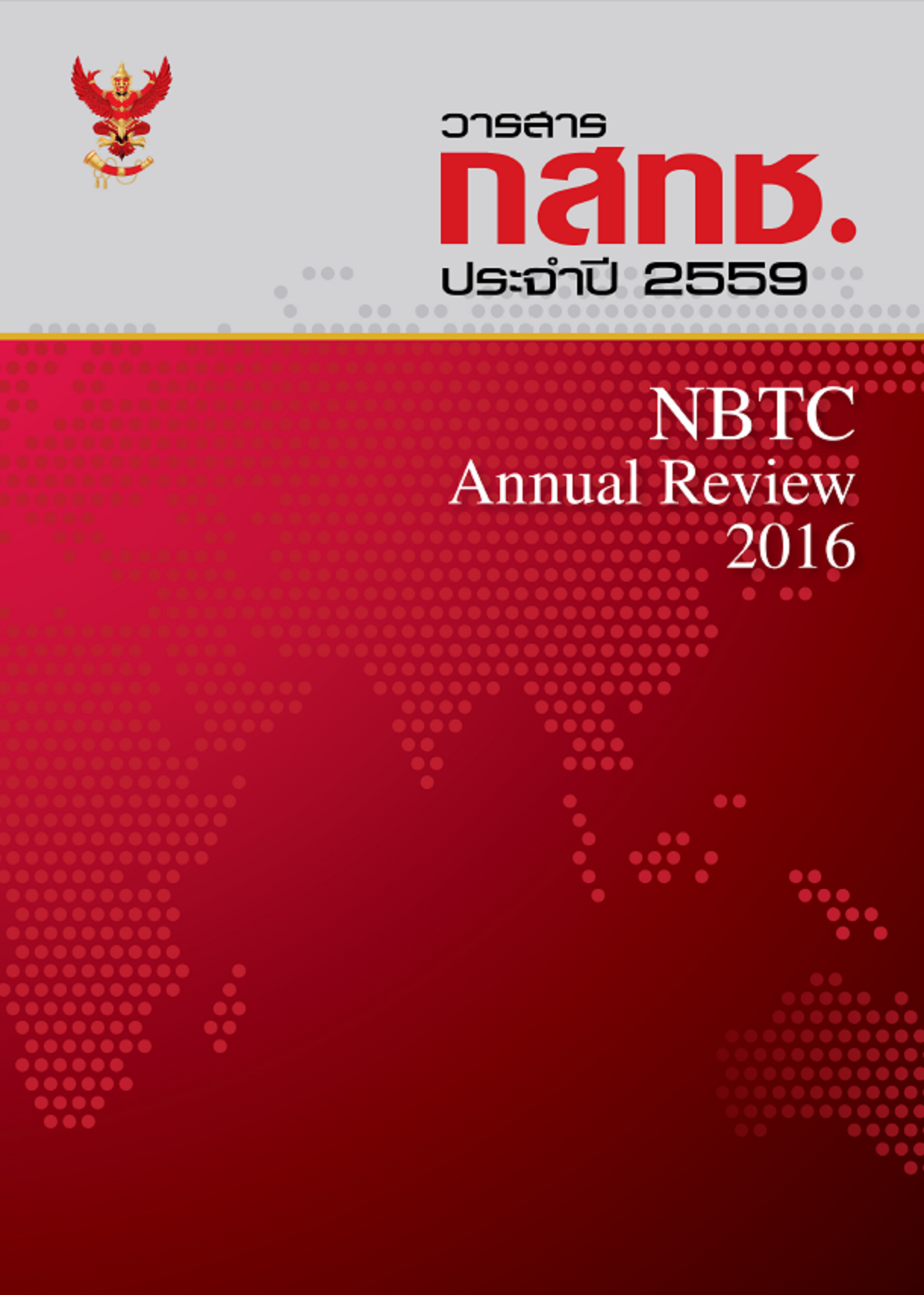Access to Telecommunications Services and Online Communication Usage among Thai Elderly
Keywords:
accessibility, telecommunications services, online communication, Thai elderlyAbstract
Thailand is now entering an aging society and moving forward in telecommunication technologies. These two important phenomena bring gaps, limitations, and barrier to adaptation between “the elderly” and “new technology”. Thai government has been trying to solve this problem by increasing accessibility of the telecommunication technologies for citizens of all ages in line with Thailand 4.0 for sustainable development. This article analyzes and presents the overview of situation in Thailand and the visible behavioral patterns of the Thai elderly during 2011-2014 using data from the National Broadcasting and Telecommunications Commission’s Survey of Thailand Telecommunications Usage projects. The findings show the accessibility of Thai elderly to telecommunication technologies continuously increases, particularly in mobile, Smartphone, and the Internet usage. The use of fixed telephone line and public telephone continue to decline. From the data it was found that the elderly’s communication behaviors have changed. They adapt to new technologies more especially to online communication. They use search engine, download music and video, use social media and chat program. Though the increasing of telecommunications technologies usage is evident, the study found that the usage of new online communication of the Thai elderly in general is relatively low. This is very obvious in rural area where there are gaps in telecommunications technology accessibility. It is recommended that in order to develop the communication strategic plan and policies, policy makers should emphasis more on the elderly who reside in the countryside so as to increase accessibility in general.
References
กรมอนามัย กระทรวงสาธารณสุข. (ม.ป.ป.). บทบาทผู้สูงอายุต่อสังคม ครอบครัว ชุมชน. สืบค้นเมื่อ 3 พฤษภาคม 2559. จาก https://hp.anamai.moph.go.th/soongwai/statics/about/soongwai/topic006.php.
กวีพงษ์ เลิศวัชรา และกาญจนศักดิ์ จารุปาณ. (2555). รายงานการวิจัยเรื่อง การศึกษาปัญหาการเรียนรู้เทคโนโลยีของผู้สูงอายุ. กรุงเทพฯ: วิทยาลัยนวัตกรรม มหาวิทยาลัยธรรมศาสตร์.
กุศล สุนทรธาดา. (2556). สูงวัยกับไฮเทค. จดหมายข่าวประชากรและการพัฒนา. 33(6) เดือนสิงหาคม - กันยายน 2556.
ไทยรัฐออนไลน์. (10 กุมภาพันธ์ 2558). คนไทยสูงอายุเล่น “ไลน์” สนั่น. สืบค้นเมื่อ 3 พฤษภาคม 2559. จาก https://www.thairath.co.th/content/480169.
ธนยศ สุมาลย์โรจน์ และ ฮานานมูฮิบบะตุดดีน นอจิ สุขไสว. (2558). ผู้สูงอายุในโลกแห่งการทำงาน: มุมมองเชิงทฤษฎีทางกายจิตสังคม. วารสารปัญญาภิวัฒน์. 7(1) มกราคม - เมษายน 2558.
ธนา ทุมมานนท์. (2557). เทคโนโลยี Second Screen ยุคทีวีดิจิตอลไทย. วารสาร กสทช. ประจำปี 2557 เล่ม 2/2. หน้า 25-45.
ธีระพงศ์ สันติภพ. (2553). ผู้สูงอายุกับการเข้าถึงระบบเทคโนโลยีสารสนเทศ. ใน สุชาดา ทวีสิทธิ์ และ สวรัย บุณยมานนท์. ประชากรและสังคม 2553: คุณค่าผู้สูงอายุในสายตาสังคมไทย. เอกสารวิชาการสถาบันวิจัยประชากรและสังคม มหาวิทยาลัยมหิดล หมายเลข 372. พิมพ์ครั้งที่ 1. นครปฐม: สำนักพิมพ์ประชากรและสังคม.
ปราโมทย์ ประสาทกุล และ ปัทมา ว่าพัฒนวงศ์. 2553. นิยามผู้สูงอายุด้วยช่วงชีวิตข้างหน้า. ใน สุชาดา ทวีสิทธิ์ และ สวรัย บุณยมานนท์ (บรรณาธิการ). ประชากรและสังคม 2553: คุณค่า ผู้สูงอายุในสายตาสังคมไทย. เอกสารวิชาการสถาบันวิจัยประชากรและสังคม มหาวิทยาลัยมหิดล หมายเลข 372. พิมพ์ครั้งที่ 1. นครปฐม: สำนักพิมพ์ประชากรและสังคม.
ภลดา วงค์ไชยา. (2557). “ประชากรไทยที่ไม่ใช้อินเทอร์เน็ต : กลุ่มคนที่เข้าไม่ถึงเทคโนโลยีการสื่อสาร”. วารสาร กสทช. ประจำปี 2557 เล่ม 2/2. หน้า 283-296.
วรรณรัตน์ รัตนวรางค์. (2558). พฤติกรรมการใช้อินเทอร์เน็ตเพื่อหาข้อมูลสุขภาพของผู้สูงอายุในเขตกรุงเทพมหานคร. วารสารพฤติกรรมศาสตร์เพื่อการพัฒนา. 7(1), 169-185.
สำนักงานคณะกรรมการกิจการกระจายเสียง กิจการโทรทัศน์ และกิจการโทรคมนาคมแห่งชาติ. (2554). รายงานดัชนีชี้วัดในกิจการโทรคมนาคมของประเทศไทย ประจำปี พ.ศ. 2553. กรุงเทพฯ: บริษัท ฮีซ์ จำกัด.
สำนักงานคณะกรรมการกิจการโทรคมนาคมแห่งชาติ. (2554). รายงานผลสำรวจพฤติกรรมผู้ใช้บริการโทรคมนาคมและวิทยุโทรทัศน์ในยุคหลอมรวมสื่อและเทคโนโลยี convergence ของประเทศไทย ปี 2553. กรุงเทพฯ: บริษัท ฮีซ์ จำกัด.
สำนักงานพัฒนาวิทยาศาสตร์และเทคโนโลยีแห่งชาติ. (2558). สำนักงาน กสทช. ร่วมกับ สวทช.เผยผลสำรวจมูลค่าตลาดสื่อสารประจำปี ’57 และประมาณการปี ’58. สืบค้นเมื่อ 3 พฤษภาคม 2559. จาก https://www.nstda.or.th/news/20458-nstda.
สำนักงานสถิติแห่งชาติ. (2558ก). สรุปผลที่สำคัญสำรวจการมีการใช้เทคโนโลยีสารสนเทศและการสื่อสารในครัวเรือน พ.ศ. 2557. กรุงเทพฯ: สำนักงานสถิติแห่งชาติ.
สำนักงานสถิติแห่งชาติ. (2558ข). รายงานเชิงวิเคราะห์เรื่องปัจจัยที่มีผลต่อการใช้อินเทอร์เน็ตของผู้สูงอายุในประเทศ พ.ศ. 2557. กรุงเทพฯ: สำนักงานสถิติแห่งชาติ.
สุปราณี ศรีฉัตราภิมุข. (2557). ยุทธศาสตร์การพัฒนาคุณภาพชีวิตและการเรียนรู้ของคนพิการ ผู้สูงอายุ และผู้ด้อยโอกาส ในยุคการหลอมรวมเทคโนโลยี. กรุงเทพฯ: สถาบันวิจัยและให้คำปรึกษาแห่งมหาวิทยาลัยธรรมศาสตร์.
สมาน ลอยฟhา. (2554). ผู้สูงอายุกับเทคโนโลยีสารสนเทศ. วารสารสารสนเทศศาสตร. 29(2), หน้า 53-64.
สมาน ลอยฟ้า. (2557). พฤติกรรมการใช้อินเทอร์เน็ตของผู้ใหญ่ในชนบท. อินฟอร์เมชั่น. 21(2), หน้า 18-28.
อรรถพล สาธิตคณิตกุล. (2558). ก้าวเข้าสู่สังคมผู้สูงวัยกับเทคโนโลยีที่ช่วยอำนวยความสะดวกในยุคหน้า.สืบค้นเมื่อ 3 พฤษภาคม 2559. จาก https://www.telecomjournalthailand.com/ก้าวเข้าสู่สังคมผู้สูงวัย.
อภิษฎา เหล่าวัฒนพงษ์. (2554). ความต้องการและแนวทางในการจัดสวัสดิการของผู้สูงอายุด้านอาชีพ : โครงการส่งเสริมอาชีพ พื้นที่กรุงเทพมหานคร. วารสารวิทยบริการ. 22(3), หน้า 56-67.
อารีย์ มยังพงษ์. (2556). สภาพและความต้องการการฝึกอบรมด้าน ICT ของผู้สูงอายุ ในเขตกรุงเทพมหานคร. Journal of Community Development Research. 6(1). หน้า 108-119.
อุไรวรรณ อมรนิมิต. (2546). การวิเคราะห์ข้อมูลโดยใช้Logistic Regression : ทางเลือกของการวิเคราะห์ความเสี่ยง. วารสารวิชาการ มหาวิทยาลัยหอการค้าไทย. 23(2), หน้า 21-35.
Bianchi, A., & Phillips, J. G. (2005). Psychological Predictors of Problem Mobile Phone Use. Cyberpsychology, Behavior, and Social networking, 8 (1), 39-51.
Ryu, M., S. Kim, & E. Lee (2009). Understanding the factors affecting online elderly user’s participation in video UCC service. Computers in Human Behavior, 25(3), 619-632.
Shapira, N. A., Barak, A., & Gal, I. (2007). Promoting older adults’ well-being through Internet training and use. Aging & Mental Health, September 2007; 11(5): 477–484.
Sum, S., Mathews, R. M., Hughes, I., & Campbell, A. (2008). Internet use and loneliness in older adults. CyberPsychology & Behavior, 11(2), 208-211.
Downloads
Published
How to Cite
Issue
Section
License
The Office of the NBTC holds the copyright of articles appearing in the journal. The Office of the NBTC allows the public or individuals to distribute, copy, or republish the work under a Creative Commons license (CC), with attribution (BY), No Derivatives (ND) and NonCommercial (NC); unless written permission is received from the Office of the NBTC.
Text, tables, and figures that appear in articles accepted for publication in this journal are personal opinion and responsibility of the author, and not binding on the NBTC and the Office of the NBTC. In case of errors, each author is solely responsible for their own article, and not concerning the NBTC and the NBTC Office in any way.



